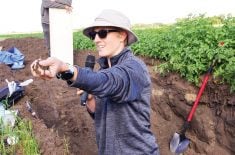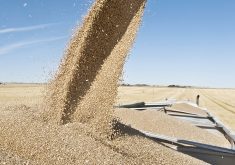Rapeseed crops are deteriorating in many important production regions around the globe.
Reports surfaced last week that the crop is in trouble in some of the key members of the European Union, which is the world’s biggest producer and consumer of the oilseed.
Dry weather is threatening crops in Germany and France, according to Reuters News Service.
Germany’s farm co-operatives have cut their production estimate to 5.19 million tonnes, down 9.4 percent from the 2010 harvest.
In France, which is the second largest rapeseed producer in the EU, analysts say the lack of rain is worrying but it’s too early to reduce the government’s estimate of a five million tonne crop, which would be up from 4.8 million tonnes last year.
Read Also

Soybean market still figuring out implications of China-U.S. pact
Soybean futures had a muted reaction to the U.S. trade deal with China as the market tries to figure out the nuances of the deal.
In an April 7 report, the U.S. Department of Agriculture’s Foreign Agriculture Service predicted 20.8 million tonnes of EU rapeseed production in 2011-12, up slightly from last year but well below the record 21.4 million tonnes harvested in 2009-10.
Europe’s crop appeared to be in good condition at the time of that report, although some areas of France, Germany, Austria and Poland needed rain to secure good yields.
Those rains didn’t come and analysts are now predicting a reduced crop.
“Alarming news has been received from several important rapeseed producing areas in Germany. Considerable winter killing has cut the winter rapeseed area,” said Oil World in an April 21 update.
The oilseed analysis firm is forecasting 20.1 million tonnes of production in 2011, which would be a three-year low.
It’s a similar story for other key rapeseed producers.
In March, UkrAgroConsult forecast a 40 percent increase in Ukraine’s 2011 rapeseed crop to 2.06 million tonnes because of minimal winter damage.
However, by early April Ukraine’s agriculture ministry reported that 10 to 15 percent of the crop had to be reseeded because of winter damage.
China’s crop is also suffering.
A recent article inThe Wall Street Journalquoted a senior official with the country’s state grain trader Cofco Ltd., who said rapeseed output is likely to fall by 15 percent to below nine million tonnes this year.
China was the top buyer of Canadian canola in 2008-09 and 2009-10. Sales through the first seven months of the 2010-11 marketing campaign are down 58 percent from the same time last year to 581,600 tonnes, partly because of China’s blackleg restrictions.
The lack of seed exports is offset by increased canola oil sales
One exception to the deteriorating crop outlook is Australia, Canada’s main competitor in canola export markets.
Rabobank said Australian farmers are well poised to “rewrite the record books” in 2011-12, with good moisture conditions in the eastern part of Australia more than offsetting lingering dryness in the west.
“The east coast is looking at a bumper crop. South Australia hasn’t looked better for years,” said the agricultural banking specialist.
Rabobank estimates a record 2.36 million tonnes of canola production, up 10 percent from last year and well above the previous five-year average of 1.54 million tonnes.
However, Australia’s crop is even further away from the bin than Canada’s so a lot can change.
The biggest question in canola rapeseed markets is how much Canadian growers plan to seed. Statistics Canada will provide that answer April 26, which is past The Western Producer’s publication deadline.
A poll of analysts leading up to the report revealed an average trade estimate of 18.2 million acres, up eight percent from last year.















